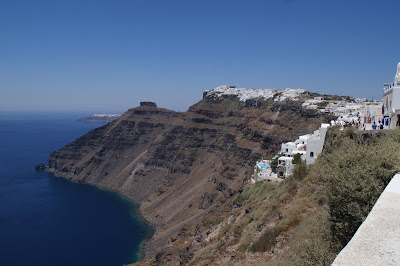The volcanic
eruption that destroyed the Minoan civilisation of Crete took place
sometime between 1500BC and 1650BC on the island of Thera, now
commonly called Santorini. The Italianate name was conferred upon it
when it formed part of the Venetian Empire.
The most southerly of the Cyclades, this circular group was once a single island, out of which the eruption blew the entire centre to a width of 12 kilometres and a depth of 400 metres, too deep for our ship to anchor, so that we were obliged to drift or steer in circles. The central lagoon is in fact the caldera of the volcano, and seismic activity is not extinct in the area. The central plug is only about 300 years old if I remember rightly.
The eruption was one of the largest in the history of the Earth and its climatic impact can be dated from tree rings. It is the probable source of Plato’s ideas about Atlantis. Without it Mycenaean culture might not have developed to replace the Minoan.
Probably unwisely,
we decided to pass on the excursion to Akrotiri, which has been
called the Greek Pompeii. Given the heat, the last thing one really
needed was a bus trip, but the excavations there remain on the bucket
list.
The town of Fira (or
Thira) is poised atop cliffs almost 1000 feet high that overlook the
caldera. You can reach the lower town from the harbour by cable car
or ‘donkey’ (actually mule). If you make the effort to climb up
from there to the upper town you are rewarded with an
unparalleled view.
The pottery on sale in the souvenir shops also makes you wish you could find some way of getting it home.
The pottery on sale in the souvenir shops also makes you wish you could find some way of getting it home.



No comments:
Post a Comment
Would you like to comment on this post?